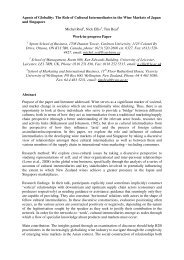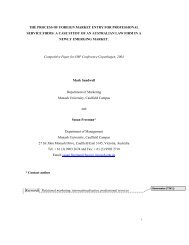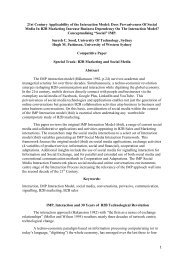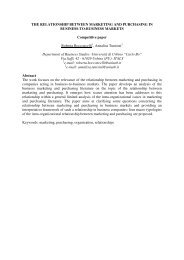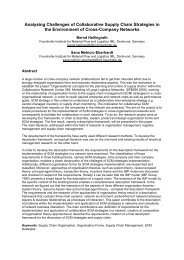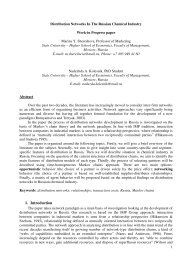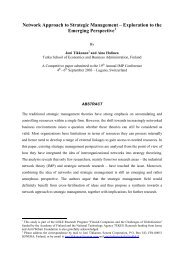Mobile Network Operators and Cooperation - IMP Group
Mobile Network Operators and Cooperation - IMP Group
Mobile Network Operators and Cooperation - IMP Group
Create successful ePaper yourself
Turn your PDF publications into a flip-book with our unique Google optimized e-Paper software.
20 CHAPTER 2. RESEARCH APPROACH<br />
• The dem<strong>and</strong> side aspects can be; the market segment <strong>and</strong> type of customers,<br />
users needs <strong>and</strong> willingness to pay, the combination of users <strong>and</strong> usage of<br />
services ( user environments), the added value of different services (how users<br />
perceive the added value) <strong>and</strong> customer satisfaction <strong>and</strong> loyalty.<br />
• The supply side include aspects like; the service offer <strong>and</strong> the value proposition<br />
(the intended added value), the cost structure, the type <strong>and</strong> number of actors<br />
<strong>and</strong> their relations, the organization of the supply chain, business roles <strong>and</strong><br />
how they are combined into a value chain, network or constellation. Included<br />
is also how firms establish <strong>and</strong> maintain their customer relations, strategies<br />
for pricing, marketing <strong>and</strong> bundling of service offers.<br />
• The technical aspects include architectural <strong>and</strong> interface design <strong>and</strong> the technical<br />
performance. Specific performance metrics like data rate, throughput,<br />
range, bit error rate should be able to be expressed in terms of more high<br />
level metrics like service availability, reliability <strong>and</strong> quality. The technical<br />
performance should be expressed as a function of different capabilities <strong>and</strong><br />
the resources <strong>and</strong> costs that are needed to provide these capabilities.<br />
Relations between different analysis aspects<br />
The analysis is seldom a one-dimensional analysis where the value of one parameter<br />
is considered. The analysis usually includes multiple parameters <strong>and</strong> trade-offs<br />
between different requirements. It is important to identify links between different<br />
aspects, what mechanisms that are inter-related <strong>and</strong> under what conditions. For<br />
deployment of wireless networks a number of characteristics are inter-related <strong>and</strong><br />
different trade-offs need to be done. E.g. more spectrum enables higher data<br />
rates, wide area coverage requires high transmission power, higher data rates means<br />
shorter ranges, <strong>and</strong> more spectrum leads to cheaper systems. This aspects were<br />
highlighted by Jens Z<strong>and</strong>er at a seminar about spectrum allocation 1 .<br />
"In principle you can deploy any type of system anywhere, it is just a trade off<br />
between different limiting factors. In the case of wireless system it is often cost,<br />
power <strong>and</strong> amount of spectrum"<br />
The trade-offs are not only done in the technical domain where you often can<br />
calculate <strong>and</strong> predict what will happen. There may also be trade-offs between technical<br />
performance <strong>and</strong> non-technical aspects. The history, existing systems, usage<br />
<strong>and</strong> market aspect also need to be considered. In addition, the own organization<br />
may put requirements or limitations on what can be achieved. This is illustrated<br />
by an example from one of the interviews with a local local transportation company<br />
in Sweden.<br />
1 Seminar "New spectrum b<strong>and</strong>s - for TV or for mobile broadb<strong>and</strong>", February 5, 2008 organized<br />
by IVA The Royal Swedish Academy of Engineering Sciences, presentations available at<br />
http://www.iva.se/upload/Ettan/Seminarier/080205KTH.pdf




